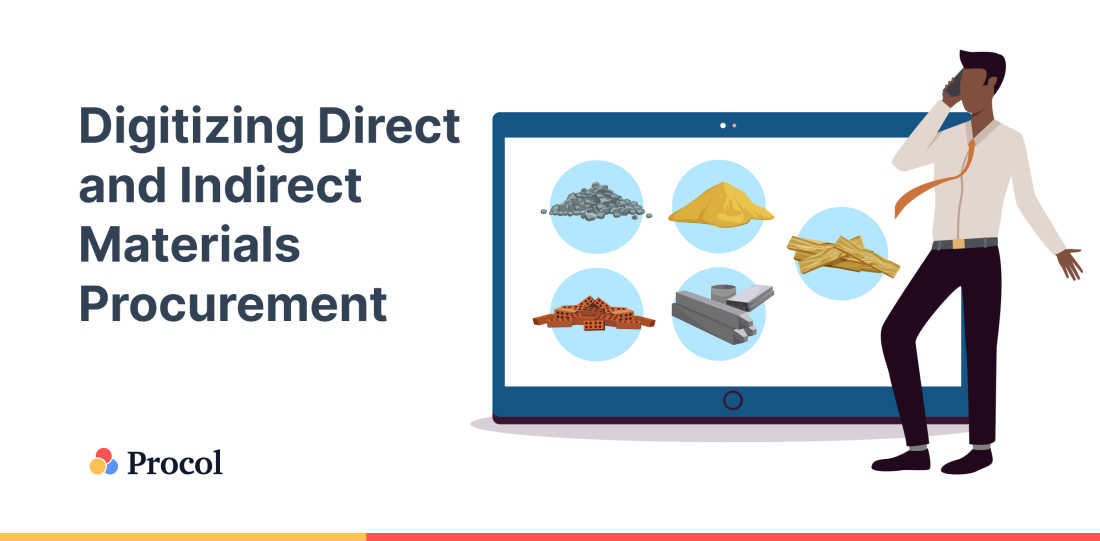Digitizing Direct and Indirect Materials Procurement

TABLE OF CONTENTS
On the surface, procurement appears to be only about getting the goods/services needed for a business to run on a daily basis. As you become more specific, you begin to include all the enabling elements that make procurement possible such as processing payments, managing vendors, preventing fraud, issuing invoices, and quality assurance.
Direct and indirect procurement can be clearly separated into two categories. While both are necessary for the operation of every organization, it’s crucial to know where they fit in so you can set priorities and give each the attention it deserves. By doing so, you’ll be able to cultivate fruitful relationships with suppliers, effectively manage procurement, and guarantee a consistent supply of the inputs required to keep your business afloat.
Quick Definitions
Whether a material is included in the Bill of Materials (BOM) for a product a business offers or is simply overhead for a company’s operations determines how direct and indirect materials are split.
Direct materials are included within the Bill of Materials as they are directly utilized into the final manufactured product. Change in direct materials can also lead to a change in costs of the final product, unlike indirect materials.Components, subassemblies, and contract manufacturing services changes are examples of these.
The cost and use of indirect materials, on the other hand, are the operating expenses required to keep a business afloat and are not directly related to a unit of product the company sells. These could be things that a business requires to manufacture, design, or develop, or just support the organization’s operation, such as office supplies, contracted company services, transport services, and similar items.
Undoubtedly, both direct and indirect buying are essential tasks in a business. Both present distinct issues of their own and negatively affect a company’s bottom line. But this blog will outline some significant distinctions between direct and indirect material buying.
Differences between Direct and Indirect Materials
The materials’ function is the main distinction between direct and indirect procurement. Indirect procurement deals with the supply of unplanned goods, while direct procurement concentrates on getting the essential supplies that are processed and supplied to your clients. There are distinctions between the ways that direct and indirect procurement each performs their various functions. As a result, to properly approach both branches, you must make a small adjustment.
- Supplier hunting
When you manage direct material procurement, you frequently have to go “hunting” for suppliers of parts or components that might not yet exist. Maybe your engineering team has developed a brand-new product that needs a particularly unique component that has never been seen before. You might also need to choose a supplier willing to abide by your strict demands for a beautiful finish or mechanical tolerances. Numerous emails, phone conversations, and even supplier visits are often required, many of which may result in failure.
- The Importance of the vendor-client connection
Direct procurement refers to procuring the materials that form the foundation of what your company provides to its clients. In other words, nothing operates without the results of direct procurement. Building long-term, sustainable connections with your suppliers can be your best advantage if you want to ensure that you can guarantee a consistent supply chain.
Contracts, minimum order sizes, vendor management, and other factors play a role in this. E-procurement solutions can help you in consolidating information and being active in outreach. Building a trustworthy customer-vendor relationship that can endure under direct procurement is necessary to provide security for both parties.
Conversely, indirect procurement deals with non-essential products that support your business operations but do not form your core business activity. As a result, indirect procurement doesn’t receive the same attention as direct procurement.
Given its significance, direct procurement fosters stronger vendor connections you can rely on, while indirect vendors can be managed with little to no effort to keep their services on a long-term basis. To offset the expense of entering into contracts, indirect suppliers are too many and frequently quite small.
- Purchase choices that are more technical with direct procurement
Since many components are technical parts or were specially created by the buying organization, direct material procurement frequently necessitates an in-depth technical understanding of the material being purchased.
As a result, numerous parties are involved in purchasing choices, including supply chain and procurement teams as well as internal engineering, product development, manufacturing, and quality groups.
- Greater internal system complexity
Companies frequently resort to technology-based solutions to move more quickly, operate more efficiently, and produce market-leading products as they seek an edge. MES (Manufacturing Execution Systems), PLM (Product Lifecycle Management), QMS (Quality Management Systems), and ERP systems are all relatively popular in today’s world, and each has its role in product development and manufacturing.
For indirect materials procurement, such integration isn’t necessary; as a result, the tools they employ to manage the procurement process can be a little less sophisticated.
For direct materials procurement, some procurement solutions are available on the market that assists with supplier relationship management and offer connectors with ERP, PLM, QMS, and other internal systems.
Conclusion
To minimize manual involvement, procurement softwares helps in encompassing all the crucial steps in the procurement process, such as the evaluation of bids, the raising and approval of purchase orders, the selection and ordering of goods and services, the receipt of invoices, the administration of contracts, and many more.
With Procol, you can simplify your sourcing requests and purchase workflows while taking complete control over your procurement process. To know more about how Procol can add value to your direct and indirect materials procurement, book your demo now!
Get a Free Demo
We'd love to hear from you. Please fill out this form to schedule a demo with us. You can also give a call on +91 76666 82222



